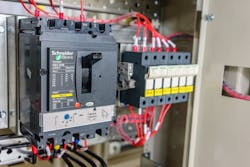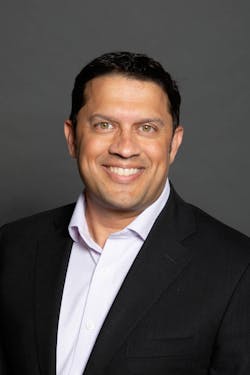Putting Backbone into the Energy Journey: The Economics of Sustainability
The commercial and industrial energy transition can sometimes seem like a chronological oddity—taking hold 10 years from anywhere. The end zone looks to be a long way off.
Truthfully, most industry sources acknowledge the future is now for deep investments in decarbonation technologies on all fronts, from renewables to electrification to microgrids and energy efficiency. While waiting may be counter-productive, the business case also must be immediate and obvious to the customer, as well.
The electrical distribution technology sector, Schneider Electric’s Rohan Kelkar said, is the backbone of the C&I energy transformational moves. And even the backbone—from switchboards to motor controls—has to make its fiscal case now.
“In the end, like everything else, we will be successful in the journey if it’s cost-effective,” Kelkar, executive vice president of Schneider Electric’s global power products division, said in an interview with Microgrid Knowledge.
“This has to make sense,” he noted. “The economics of sustainability and changing the way you do power management has become a local topic.”
Making the Fiscal, Resiliency and Sustainability Cases for Microgrids
Microgrid Knowledge 2024 Happening April 22-24 in Baltimore
Join us to Celebrate a Decentralized Revolution in Energy
Local means here and now. Some of the fruits of decarbonization are not as evident in the near term as they will be years down the road, but CFOs and sustainability managers need to calculate the cost-benefit ratio at this moment.
Schneider Electric’s power products unit creates the tools that convert the digital to the operational. A microgrid, for instance, is a body made up of three parts: the controller, which is the brain; the generation assets, which are the physically active components; and the connective tissue such as the circuit breakers, switchgear, and boards which shift digital control to generation output, whether it’s solar, batteries or gen-sets, he added.
“We were kind of the sleepy side of the industry, as everybody focuses on the generation side,” Kelkar said.
But now a giant has awakened as the future of distributed energy and resiliency of the overall grid increasingly relies on bi-directional flow of energy. Think virtual power plants, microgrids, vehicle to grid, and etc.
Electric utilities face an extreme challenge, both commercially and technically, to their one-time and one-way dominance, Kelkar said. Prosumers are gathering power and decentralized or distributed energy resources (DER) are combining forces to create a gathering storm to the old ways.
Yet the disturbance in the force must be harnessed and controlled to benefit all parties. That’s where artificial intelligence (AI) and on-site installation of direct current (DC) DERs comes into play.
“In a way we have too much data and too little insight. . . Technically, how do you manage it? Operationally how do you manage it?” Kelkar added. “Some grids are not capable of handling it, and that creates challenges and opportunities.”
Microgrids are becoming ever more prominent dotted along the energy landscape in the U.S. and around the world. Transparency Market Research, for one, estimates that the microgrid sector is growing about 11 percent annually and may more than triple from 2020 to $206 billion in value by 2031.
DC appears to offer the best use-case flow for that scaling up, many industry leaders said at the RE+ event earlier this fall, echoing Kelkar’s thoughts on the subject.
DC microgrids can offer several key efficiencies and higher integration of on-location resources such as rooftop solar and battery storage. Many industry experts, including Kelkar, believe it could be the preeminent method of electricity distribution for the future.
“Scratching the surface of this frontier are DC microgrids,” he pointed out, while noting that Thomas Edison was pushing direct current as a primary electric transmission method nearly 150 years ago, losing out to Tesla, Westinghouse and alternating current.
DC, however, is A-Ok and ideal for on-site power power generation since much of the equipment is already built for direct flow.
“To manage and scale that microgrid, the larger number of sources and loads are a complex challenge (best solved) with DC,” Kelkar said.
AI’s rise and resulting growth in power load is close to 10-fold over what it was even a decade ago. The data center and cloud sectors require connection and generational capacity beyond what the traditional grid can likely offer, not even taking transportation electrification into account.
“Can we design things smartly so they can draw less power?” Kelkar asked. “We’re going into the basic principles of design. Second, when we deploy a product can we dynamically manage the consumption?”
There’s good old sleepy energy efficiency again, a “first fuel” for decarbonization that benefits from digital controls, sensors and AI to make sense of all that data.
And reducing greenhouse gas emissions is ever more crucial as climate change unleashes its impact with accelerating ferocity.
“There’s education and urgency to take action around sustainability and decarbonization,” Kelkar noted. “It is very top of mind for all of these companies. The question is how can we do it and not collapse the grid?”
About the Author
Rod Walton, Microgrid Knowledge Managing Editor
Managing Editor
For Microgrid Knowledge editorial inquiries, please contact Managing Editor Rod Walton at [email protected].
I’ve spent the last 15 years covering the energy industry as a newspaper and trade journalist. I was an energy writer and business editor at the Tulsa World before moving to business-to-business media at PennWell Publishing, which later became Clarion Events, where I covered the electric power industry. I joined Endeavor Business Media in November 2021 to help launch EnergyTech, one of the company’s newest media brands. I joined Microgrid Knowledge in July 2023.
I earned my Bachelors degree in journalism from the University of Oklahoma. My career stops include the Moore American, Bartlesville Examiner-Enterprise, Wagoner Tribune and Tulsa World, all in Oklahoma . I have been married to Laura for the past 33-plus years and we have four children and one adorable granddaughter. We want the energy transition to make their lives better in the future.
Microgrid Knowledge and EnergyTech are focused on the mission critical and large-scale energy users and their sustainability and resiliency goals. These include the commercial and industrial sectors, as well as the military, universities, data centers and microgrids. The C&I sectors together account for close to 30 percent of greenhouse gas emissions in the U.S.
Many large-scale energy users such as Fortune 500 companies, and mission-critical users such as military bases, universities, healthcare facilities, public safety and data centers, shifting their energy priorities to reach net-zero carbon goals within the coming decades. These include plans for renewable energy power purchase agreements, but also on-site resiliency projects such as microgrids, combined heat and power, rooftop solar, energy storage, digitalization and building efficiency upgrades.


